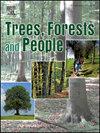Altered composition and structure of plant communities in response to Lantana camara invasion in forest ecosystems of Kumaun Himalaya, India
IF 2.7
Q1 FORESTRY
引用次数: 0
Abstract
Ecosystem stability is being threatened by the invasion of exotic plant species. This study examined the impact of Lantana camara (Verbenaceae) on associated plant communities and regeneration status across three different forests: Banj oak (Quercus leucotrichophora), Chir pine (Pinus roxburghii) and Sal (Shorea robusta) in Kumaun Central Himalaya, India. In each forest site, two paired plots (invaded by L. camara and uninvaded) of 0.5 hectare each were established. Within each plot, 5 random quadrats of 10 × 10 m for trees, 10 quadrats of 5 × 5 m for shrubs and 20 quadrats of 1 × 1 m for herbs were sampled and community variables for each species were recorded. Regeneration status was studied by classifying individuals into different size classes and developing population structure for tree species. Results showed decreasing trend in the density (92 % in oak, 74.7 % in pine, and 80.3 % in sal forests) and basal area of tree layer in invaded plots. However, shrub and herb layers exhibited higher density and diversity in invaded areas. Tree regeneration was decreased in invaded sites with few seedlings converting to sapling and mature trees mainly in oak and pine forests. Statistical analyses (ANOVA) revealed that invasion had significant impact on density, diversity (H′), evenness (e) and species richness (SN), especially in the seedling and shrub layers. Principal Component Analysis indicated that variation due to invasion was explained by differences in diversity, species richness and dominance. The invasion by L. camara led to increase in the shrub and herb layer, which in turn had a detrimental impact on the tree layer of the studied forests. The observed decline in species diversity and richness indicate loss of ecosystem resilience and function. This decline in the native flora could have long-term harmful effect on the forest ecosystem.

印度Kumaun -喜马拉雅山森林生态系统植物群落组成和结构的变化及其对柽柳入侵的响应
外来植物的入侵正威胁着生态系统的稳定。本文研究了马鞭草科(Lantana camara)对印度Kumaun喜马拉雅中部三种不同森林(Banj oak (Quercus leucotrichophora)、Chir pine (Pinus roxburghii)和Sal (Shorea robusta)的相关植物群落和更新状况的影响。在每个样地建立了2个成对样地,每个样地面积0.5公顷,分别为柽柳入侵样地和未入侵样地。在每个样地内随机抽取5个10 × 10 m的乔木样方、10个5 × 5 m的灌木样方和20个1 × 1 m的草本样方,记录每种物种的群落变量。通过对不同大小级的个体分类和种群结构的发展,研究了不同树种的更新状况。结果表明:入侵样地的乔木层密度(栎林92%,松林74.7%,盐林80.3%)和基岩面积呈下降趋势;灌丛和草本层在入侵区表现出较高的密度和多样性。入侵地树木更新速度下降,以栎林和松林为主,幼苗转化为幼树和成熟树较少。统计分析(ANOVA)表明,入侵对密度、多样性(H′)、均匀度(e)和物种丰富度(SN)有显著影响,特别是在幼苗层和灌木层。主成分分析表明,物种多样性、丰富度和优势度的差异可以解释入侵引起的变异。柽柳的入侵导致灌木和草本层的增加,进而对乔木层产生不利影响。物种多样性和丰富度的下降表明生态系统恢复力和功能的丧失。本地植物群的减少可能对森林生态系统产生长期的有害影响。
本文章由计算机程序翻译,如有差异,请以英文原文为准。
求助全文
约1分钟内获得全文
求助全文
来源期刊

Trees, Forests and People
Economics, Econometrics and Finance-Economics, Econometrics and Finance (miscellaneous)
CiteScore
4.30
自引率
7.40%
发文量
172
审稿时长
56 days
 求助内容:
求助内容: 应助结果提醒方式:
应助结果提醒方式:


